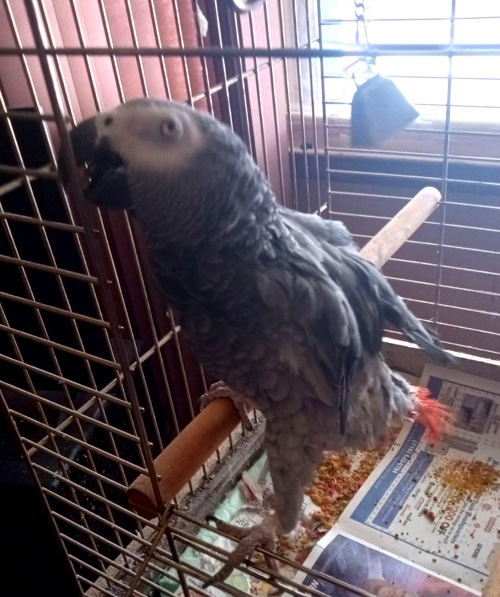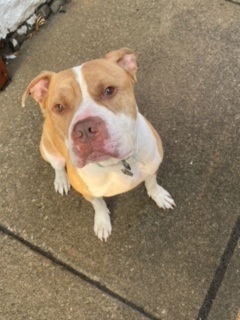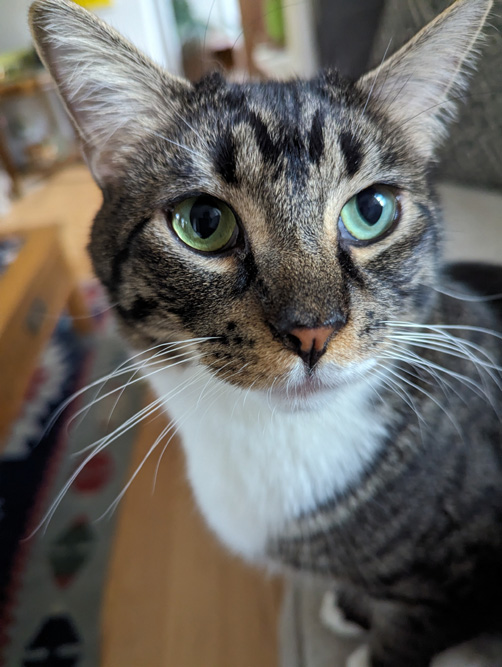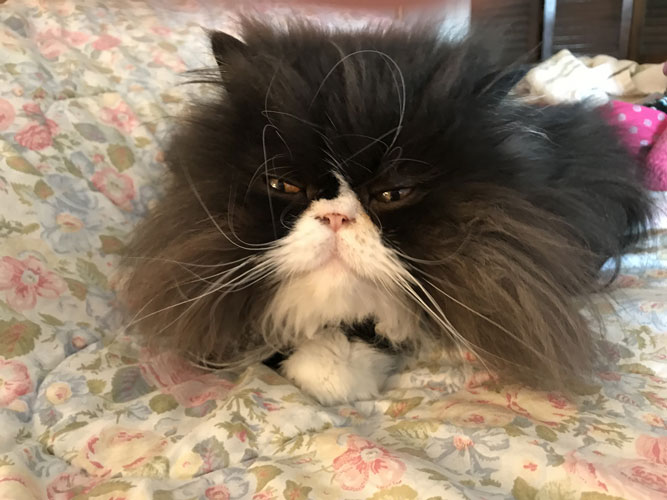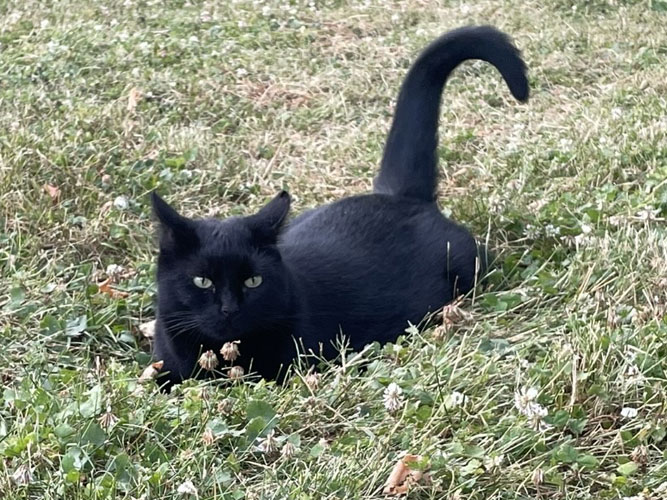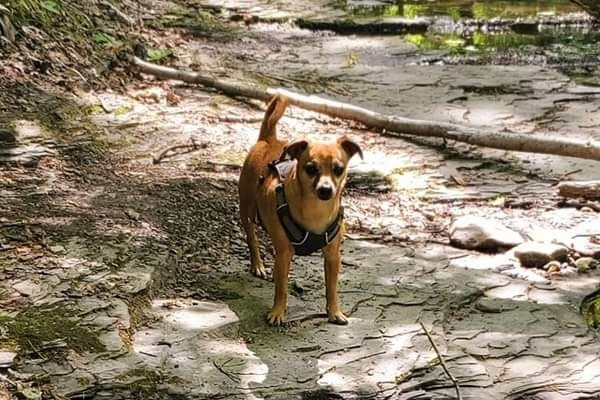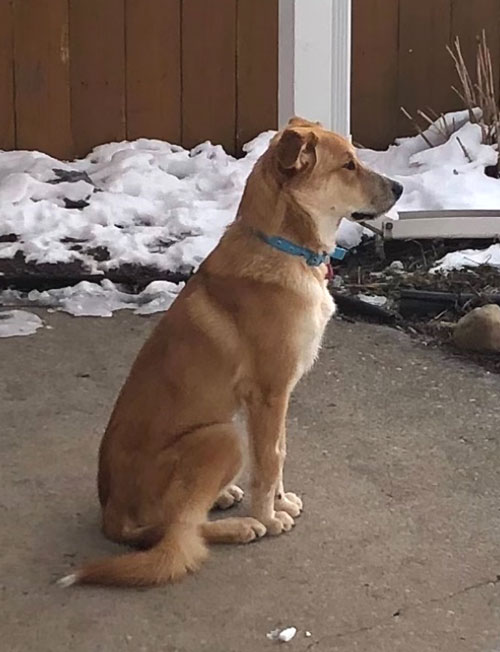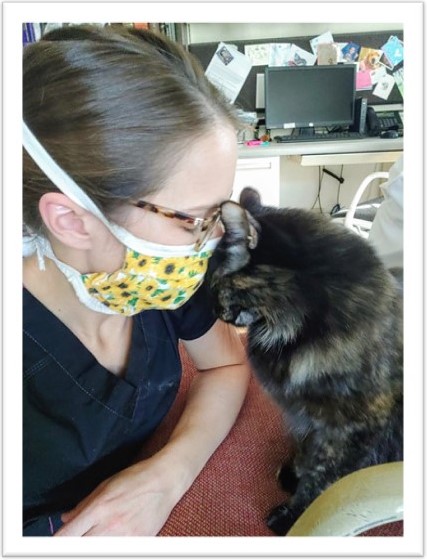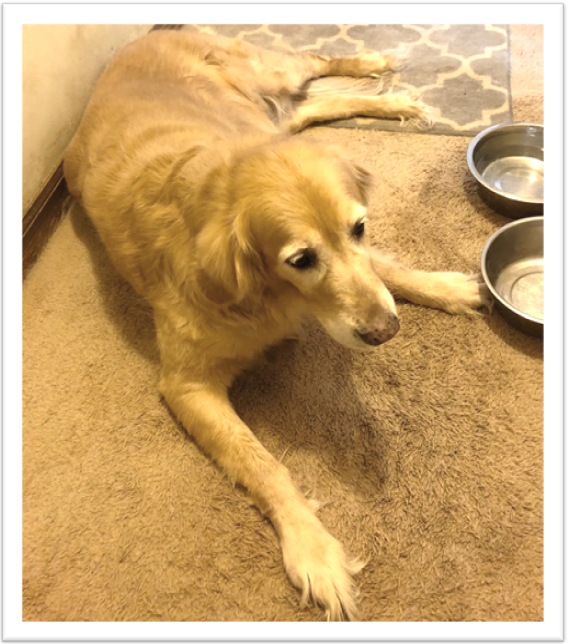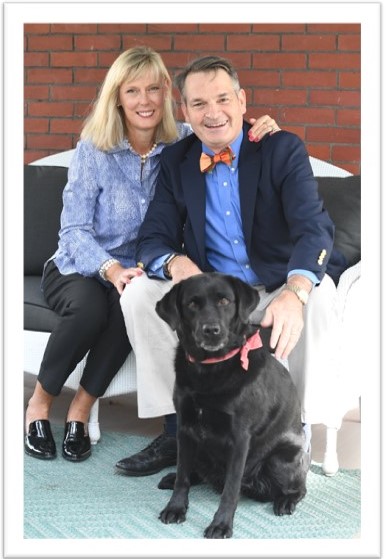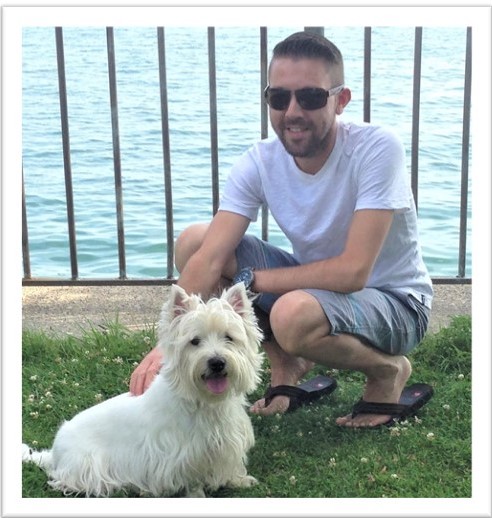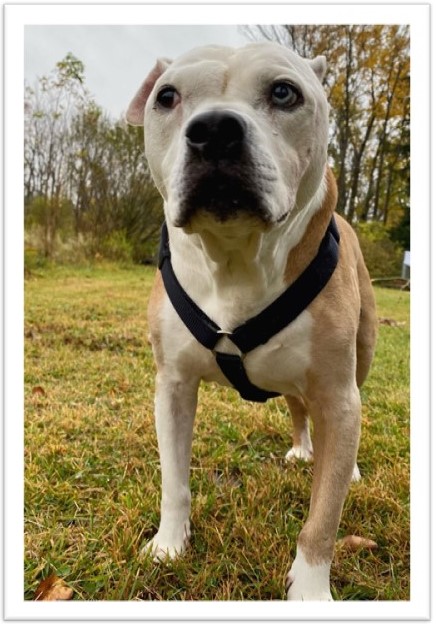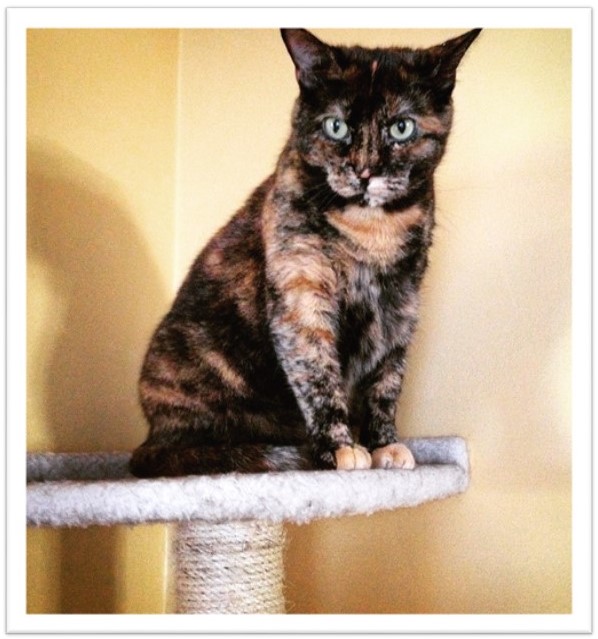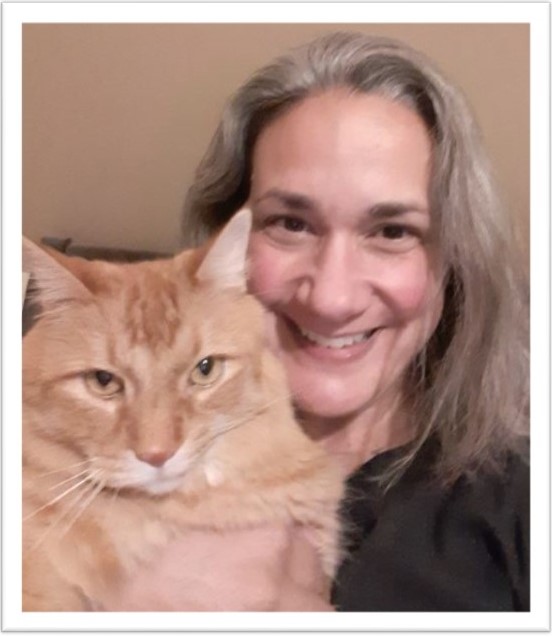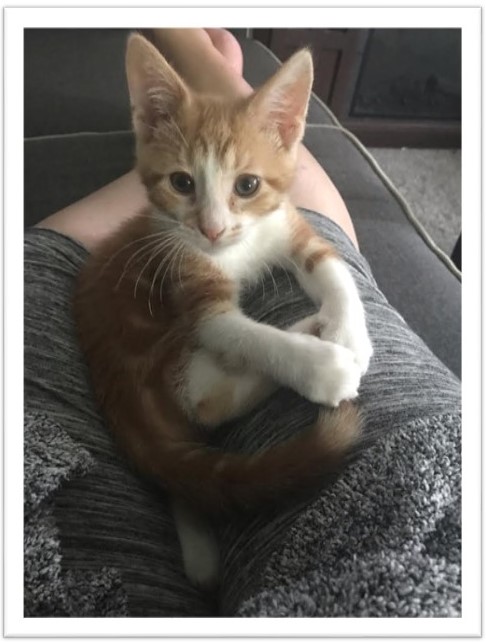Success Stories
On a wing and a prayer
December 2024
Sometimes it feels like the recovery of a pet rests on a wing and a prayer. Just ask Lancaster Ronald Panczak, who has a Congo grey parrot named Nikki.
Panczak obtained Nikki 33 years ago from a breeder at a bird club he and his wife were members of. They had a parrot at the time, but wanted an “African grey,” who they picked out when Nikki, born on Valentine’s Day, was a baby.
“We would go down to the breeder’s house a couple days a week and he’d teach us how to hand-feed it,” Panczak recalled. “When it was six weeks old, we took him home and have had him ever since.”
Nikki, who is grey with a red tail, talks a lot and lets Panczak know when he wants to come out of the cage. “He’ll climb on part of the bars and pick at one to make a loud noise. When he’s outside of the cage, he’ll follow me around and look for me.”
Panczak believes something scared Nikki on a December night in 2023, causing him to injure one of his wings when he fell to the ground. Dr. Laura Wade of Specialized Care for Avian & Exotic Pets in Clarence examined Nikki’s wings and found broken bones. After putting what Panczak said looked like a “big Band-aid” over the wing, she fitted a collar around the bird’s neck to keep from picking at it. But after Nikki ripped the collar off twice, the veterinarian concluded the wing had to be amputated. The cost for the visits and surgery was daunting – nearly $3,000.
That’s when Wade told Panczak about the Pet Emergency Fund, which kicked in $477. “Without it, I wouldn’t have been able to have that surgery,” Panczak said. “I am on Social Security and my wife has cancer and dementia and is being taken care of by hospice. I have a lot of bills, and it helped out a lot.”
Nikki is now in a smaller cage – and has a diamond dove for company — because he no longer has good balance with one wing. “He’s doing well now,” Panczak said. “I take him out of his cage every day and let him walk around the house, and if I leave at night, I put him back in the cage with fresh food.” That’s typically sunflower seeds mixed with other bird seed, to go with the pellets he normally eats.
Panczak is now looking to sell his two large parrot cages and donate the money to the Pet Emergency Fund. “They helped me out, and I don’t know what else I would have done,” he said.
Vets Solve Dior’s Knotty Problem
September 2024
How Dior swallowed the kind of knot you’d find at the end of a tug-of-war rope was anyone’s guess.
But before it was known why the 5-year-old pit bull had suddenly lost interest in eating, Medria Lee took her dog to the vet’s to find an answer. “Sometimes he’s finicky, and if he doesn’t want to eat he won’t,” said Lee, who lives in Cheektowaga. But she didn’t think this didn’t was that, and she was right.
Dior was given IV fluids and nausea medicine because even though he wasn’t eating he was throwing up. After returning home, he drank water but still wasn’t showing an appetite, and so two days later he went back to the vets for blood work and x-rays — and that’s when they found Dior had an intestinal blockage.
Because he wasn’t stable enough for surgery, he was given IV fluids again and an antibiotic to address the aspiration pneumonia he had also developed.
“I was worried,” Lee said. “The vet said he was in pretty bad shape and so weak that if they did the surgery, they weren’t sure he’d pull through. That just sent me into a whirlwind of different feelings. I was a basket case.”
There were also financial concerns. The cost for medical treatment was over $3,000, and though Lee had “a little bit of savings” and would apply a portion of her paycheck, affording the unexpected surgery was a tall order. There had also been other recent strains on her finances, but, she said, “I had to give him a chance.”
That’s where the Pet Emergency Fund came in. Her veterinarian introduced the idea of the fund helping, and it ultimately paid about half the cost, ensuring Dior would get the life-saving surgery he needed.
“I think PEF is wonderful for people like myself who don’t have a lot of money, and can’t cover emergency costs,” Lee said. “Words can’t describe how I feel about it.” The surgery, which required removing a portion of Dior’s intestines damaged by the knot, was successful, bringing a happy ending to a scary saga. “Dior is this happy baby all over again,” Lee said.
After Unexpected Costs for One Cat, and Then a Second, a Helpful Hand
May 2024
As pet owners with multiple animals know, trouble can come in spades. Shannon Lyons, a Buffalo resident, found that out earlier this year.
When Vivien, a tuxedo cat, became sick with an infection, Lyons took the kitty to her veterinarian for treatment. At his recommendation, she took Vivien for additional testing at a veterinary hospital in Orchard Park, where the cat was kept for two nights before being released.
A week after Vivien returned home to recuperate, Lyons noticed her cat Romeo, a brown tabby, had become suddenly under the weather. “Romeo is quite rambunctious and chaotic, and always into something,” she said. “At first, I thought he probably got into something he shouldn’t have and would be fine. But he went and hid, which is not his typical behavior; he’s very much a social creature. That’s when I knew something wasn’t right with him.”
That meant another trip to the veterinarian, where Romeo was also diagnosed with an infection. After the unexpected $4,000 veterinary expense of a week earlier, Lyons asked about getting help from the Pet Emergency Fund. She had put money in the coin box on the counter in the past, thinking she was helping “pay it forward,” so she knew the organization existed to help people with unexpected veterinary costs.
“I never imagined I would be a recipient, and I was so grateful that it was there, and I was able to use it,” Lyons said. “I turned to the Pet Emergency Fund because I had just had a cat with major medical expenses within a week and I knew I would not be able to pay for it on my own. Having it there took a lot of the stress away.”
Romeo was treated with antibiotics and, like his sister, is all better now and back to being his boisterous self, Lyons said.
‘I Never Thought I’d Need to be a Recipient’
September 2023
Robin Janiak had a pet emergency in April that came at a particularly inopportune time.
The Amherst resident was grooming Sadie, her 8-year-old Persian kitty, trying to remove matted hair with scissors in one hand and a comb in the other, when she accidentally cut her cat’s rear left leg.
“Sadie didn’t yell, but I looked and thought, that’s not good. It didn’t look like something that was going to put itself back together again,” Janiak said. So, she made an appointment and took Sophie to the Georgetown Animal Clinic. “I was already a shaking mess because I hurt my kitty,” she said.
Making matters worse, Janiak said, was that she had been out of work as an interior decorator and sales person after fracturing her knee and tearing her meniscus. The doctor who saw Sadie stitched the wound, treated her with antibiotics and a pain medication, and put a cone to wear around her head while she healed. When Janiak went to the counter to pay, a credit card in hand, she was not sure how she was going to afford it. But she didn’t have to. “They said they would put the charge through the Pet Emergency Fund, and I just started crying,” Janiak said. “I have probably donated to that fund before not thinking anything of it,” she said about the honor boxes found at the Georgetown clinic and many other veterinary offices. “I never thought I would need to be a recipient, but there I was in need and the Pet Emergency Fund was there for me. It meant so much.”
Sadie had her stitches removed at her return appointment and was given a clean bill of health. “She is doing great, and keeping up with her brothers Butch Cassidy and the Sundance Kid,” Janiak said. About a month later, she received a small commission check from her job, and sent $100 to Georgetown with a note of gratitude.
“I thanked them profusely for helping me out,” Janiak said, “and asked them to give the money to the Pet Emergency Fund so that there would be funds for the next person who needed an emergency.”
‘I Can’t Go Home Without Tupac’
December 2022
Tupac showed up one day about five years ago folded into Elizabeth Maniccia’s front porch swing. One cold and rainy day, she let the black cat into her City of Tonawanda home, despite her landlord not allowing pets. While skittish at first around adults, Tupac was comfortable around her children, sometimes walking with them to the bus stop.
Eventually, Tupac — named by her original owner a few blocks away, who didn’t want to keep the cat — began sleeping at Maniccia’s house or a neighbor’s who also took her in. “The neighbor and I bonded over the cat,” Maniccia said. “Every day we’re texting as to whose house she’s in. If she’s not in either house by 4:30, we’re out looking for her.”
The well-liked neighborhood cat runs off other cats on the block, but a few years ago she suffered an injury from a fight that became infected. After a trip to the vet, Tupac was forced to wear a drain coming from her stomach for weeks before she healed, with Maniccia footing the bill.
A fight Tupac had this past March, with a cat or possibly a raccoon, ended with bloody front and back paws on her right side that required casts on both legs. This time, Maniccia needed the Pet Emergency Fund’s help. to pay the $980 veterinary bill. “I was panicking and calling my sister,” Maniccia said. “As much as we don’t own the cat, I told the vet that I can’t go home without Tupac. We have all grown very fond of her.”
The Pet Emergency Fund provided $350 toward the cost, helping to make the unexpected medical care possible, Maniccia said. “The Pet Emergency Fund was great. I didn’t even know you existed. I said what I could pay, and they pulled from the fund for the difference.”
Maniccia said there are many other pet owners who could benefit from the PEF, too. “There are owners out there who should be taking their animals to the vet, but don’t have the money to do that,” she said. “If they knew the Pet Emergency Fund existed, I think they would for sure.”
Rito Burrito and the $2,500 Potato
September 2022
Rito Burrito was a little dog that suddenly developed a very big problem.
When the part-chihuahua, part rat terrier was a puppy, he suddenly stopped eating for days, leading Samantha Leigh to take him to see a veterinarian. “He was very lethargic, and he wasn’t going to the bathroom, so I took him to the vet and said, ‘What’s wrong?’ “ Leigh said.
It turned out that a tiny potato that Leigh was using for a stew she was cooking in her Kenmore kitchen had fallen to the ground, which Rito Burrito scooped up. An x-ray showed it had lodged in the 7-pound puppy’s sphincter, near his stomach. “It got stuck there — a $2,500 potato,” Leigh said, referring to the cost of surgery that was needed immediately to remove the obstruction. “I, being a single mom at the time, didn’t have the money, so the vet told me about the Pet Emergency Fund and we applied.”
This happened six years ago. Leigh recalled the PEF provided “at least one-third” of the cost of the surgery, which she was deeply grateful for.
Rito Burrito was in the hospital overnight. “He recovered fast,” Leigh said. “He made a full recovery and is a very happy dog.”
The family had suffered the loss of another chihuahua, Senior Paco, and despite the cost of surgery, they were determined to make sure Rito Burrito remained a member of the family.
“We had to keep Rito,” Leigh said. “He was going to make it through, and we were going to make it in the end.”
Saving ‘the Charcoal Cat’
June 2022
The electrical fire began in Aimee Tuttle’s daughter’s bedroom and spread rapidly.
Fat Buddy didn’t get out.
It was just before midnight on Dec. 30, 2021, when the fire broke out on the second floor of a three-story Niagara Falls apartment building. Another cat in the house was on the stairs leading out of the house, so it wasn’t hard to remove her. But as Tuttle reached for 4-year-old Fat Buddy, the skittish cat ran toward the fire. Before she could react, firefighters told Tuttle to leave immediately with her son and daughter. Then things in the apartment went from bad to worse.
“My house exploded within five minutes,” Tuttle said. “Every window was blown out and my whole apartment was on fire. There was no saving it, and my cat was still inside.”
It took the firefighters around two hours to extinguish the fire. During that time, Tuttle wasn’t allowed to go back in to look for Fat Buddy. After the fire was out, a firefighter emerged with the gray cat in his arms, burned head to toe. “He was a charcoaled cat,” Tuttle said. “It didn’t look like my cat until my boyfriend told me it was.”
The firefighter put oxygen over Fat Buddy’s nose in the fire truck, and at the suggestion of the Red Cross called a nearby veterinary clinic for emergency treatment. The clinic initially balked, Tuttle said, because she had no money to pay when she walked in the door. The clinic relented after the firefighter got on the phone and explained that Tuttle had lost all of her possessions in the fire.
Tuttle, who had run out of the house without shoes in the winter chill, drove with her daughter to the veterinary clinic, arriving around 2:30 a.m. Fat Buddy, who came into Tuttle’s life through an adoption at the Niagara SPCA, had so far survived the fire and the deluge of water used to put it out, even as a family hamster wasn’t so lucky. The examination found Fat Buddy’s breathing and lungs were doing well, but he was burned from head to toe, with singed hair and skin above his eyes. In addition, the pointy part of his ears, his belly and all of his paws were badly burned, and he lost a finger on his front left paw.
Fat Buddy was shaved, fed intravenously and hospitalized for two days. The cost for the emergency medical treatment came to $3,200, a sum well out of her reach, Tuttle said. The Pet Emergency Fund covered almost one-third of the cost by providing $1,000 and the clinic had its own fund that was used to substantially lower the cost. “What the Pet Emergency Fund did was a really big help,” Tuttle said. “I’m so thankful. It’s one thing I don’t have to stress out about.”
In the nearly six months since, Fat Buddy has continued on the mend, with another vet closer to home prescribing burn creams and antibiotics to address an infection.
“Fat Buddy is actually amazing,” Tuttle said. “His stomach and front paws have healed, though his back paws aren’t yet. His hair is finally growing back. I always tell everyone that he’s been through hell and back and he’s survived it.”
A Close Call
March 2022
How many of us haven’t wondered how our dog wound up with something dangerous in their mouth, or worse, learned they swallowed it? That’s what happened with Beebe, a half Australian Cattle Dog and half Great Pyranhees that Dawn Szymcvak acquired as a rescue last August.
Beebe swallowed a rubber stopper, the kind of thing found on the end of handlebars on a children’s bicycle with streamers coming out of one end. But that wouldn’t become known for a couple of days, after emergency surgery on New Year’s Eve at Blue Cross Animal Hospital removed the object blocking her small intestine.
“She would have died that day without the surgery,” Szymcvak said.
The bill was $2,500, with the Pet Emergency Fund providing $800 to help lessen the load. “The animal hospital was so awesome,” Szymcvak said. “They were so kind and took such good care of her, and the Pet Emergency Fund is a great organization that was extremely helpful. I will be buying bandanas every time I’m in the clinic,” she said referring to PEF merchandise sold there.
As much as Szymcvak wanted to give Beebe a good home, though, she came to realize the adoption wasn’t a good fit. She was told the dog was around 9 months old when it turned out she was about half that age. It soon became clear that Beebe was too big for Szymcvak’s house and yard. “She got way bigger than I anticipated,” Szymcvak said. “She is an awesome dog, but she is just way too energetic. A trainer said she needs a farm and a flock of sheep.”
Beebe was returned to a foster home until they can find a suitable match. “I feel terrible it didn’t work out at my house because she’s had a rough start in life, but it wasn’t a good fit. I tried, I really tried,” Szymcvak said.
Szymcvak did more than just try — she paid for life-or-death surgery for Beebe that gives the dog another chance in life.
“I was in love with this dog,” she said. “I didn’t just do it for myself, I did it for her. She needs more room to run and another dog would be awesome for her to help her get some of that energy out.” Szymcvak said she is going to adopt another rescue dog, but this time one she knows is a little older so she’s sure “it’s not going to be the size of a small horse.”
Hopefully one without a penchant for finding rubber stoppers, either.
‘Mr. Moose Caboose Finds His Way’
November 2021
Johnathan Worden’s children’s book, “The Great Dane Chronicles: Mr. Moose Caboose Finds his Way,” has sold close to 2,000 books this year – a total that’s especially impressive considering it’s self-published. Ten percent of the proceeds are being donated by the Town of Tonawanda resident to benefit the Pet Emergency Fund at Sheridan Animal Hospital.
Worden made the decision to help the PEF after Moose, his 11-year-old Great Dane and the subject of the book, died three weeks after a sudden limp led to an x-ray that revealed an aggressive bone tumor in his leg. Moose’s death came on March 7, one week after the book was published.
“There was all this excitement about the book and the heart-wrenching knowledge that we were going to lose him any day, and then we did,” Worden said. “As quickly as that happened, I thought I really need to give back for this one. The vets at Sheridan Animal Hospital were always great. I wanted to give it to the Pet Emergency Fund because, although we could afford the care, I thought about what it would have been like if we couldn’t.”
The book, with illustrations by Ayan Mansoori, sells for $11.98 and is available online from Amazon and at the Book Worm, 34 Elm St., East Aurora, Daisy’s Doghouse, 448 Hertel Ave., Totally Buffalo Store, 3328 Sheridan Dr., Amherst, and Revolution Indoor Cycling, 1716 Main St.
The 45-year-old Syracuse native, who moved to Buffalo at age 18 to attend Buffalo State College, said writing the book was on his “bucket list.” “It started with me being obsessed with my Great Dane, and really paying attention to everything around us,” Worden said. “When going on walks with Moose I’d see how people reacted to his size, including pulling their dogs away from him. I started to think it was an issue I could probably make a story about – about Moose finding his identity.”
The book’s target age is 4-7, though kids a little older may also enjoy it, Worden said. The first sentence reads, “I used to be so confused about who I was and who I was supposed to be. I realized from the time I was a little boy that I was very different.” “That tells people what the book is going to be about, but it doesn’t necessarily tell the child that, because they’ve never had that thought,” Worden said.
A sequel is due out in January 2022 that will be called “Mister Moose Caboose and the Lavender Goose.” Worden said that with Mr. Moose Caboose now “comfortable in his own fur,” he recognizes others that are struggling with who they are. He coaches them to understand they don’t have to change but need to like themselves. Worden is also at work on a third book about Duke, a second Great Dane owned by Worden and husband Nicholas Boucounis.
In the meantime, Worden continues to find ways to honor Moose’s memory. A plaque now adorns the rock garden outside Sheridan Animal Hospital established for people whose pets have died. It’s named “Moose Caboose Memorial Garden.”
Paying it Forward for Toby
October 2021
Christine Bardwell knows a thing or two about paying it forward.
The Town of Tonawanda resident, who takes her dog Toby to Northtown Animal Hospital, was given $1,500 last fall to use from the Pet Emergency Fund to help pay for surgery and treatments for heartworm. Bardwell paid $1,300 back, though under no obligation to do so, because she wanted the money available for others in need.
“When dogs need veterinary help, sometimes people don’t know what they’re getting into, and it can be heartbreaking not to be able to afford the treatment,” Bardwell said. “I felt bad about accepting the money because I felt there was someone else who would need it more.”
Toby, a terrier or schnauzer mix, is a young dog who came into Bardwell’s life in September 2020 from a local rescue. He is generally fearful of people, especially men, leading Bardwell to assume he was mistreated at an early age. But Toby’s very affectionate with her. “He’s the best,” she said.
Toby was in poor health when she got him. She took the dog to Northtown Animal Hospital, and he was diagnosed with heartworm, tapeworm and roundworm. “The vet told me if I hadn’t brought him in in the next few days he would have died,” Bardwell said. The rescue organization said they’d take Toby back, but otherwise wouldn’t help pay the veterinary cost or refund the fees they charged. Bardwell went ahead with the treatments anyway.
But Bardwell is a senior citizen on a fixed income who lives with two dogs. She had also already spent a considerable sum on her previous dog’s health. The retired social work examiner worried how she was going to pay for Toby. “I don’t have that much money to throw around, but I didn’t think about the money. I just thought about making him better,” she said. The staff and doctors at the animal hospital were supportive. “When I was told about the help from the Pet Emergency Fund, I thought they were kidding. I was very grateful. It’s not that I didn’t want help, but I thought maybe someone needs it more than me.”
Because Toby’s condition was so advanced, he was referred to Cornell University College of Veterinary Medicine for an operation. “I was scared to death to go – I don’t even leave the house!” Bardwell said of the drive to Ithaca. Pinchers were used on a carotid artery in Toby’s heart to extract 16 12-inch-long heartworms. Toby was prescribed heart medicine and given Viagra to dilate blood vessels allowing the heartworms to pass through. The dog was later treated for worms in his arteries.
Recovering at their Tonawanda home, Toby needed to be still for the next six months out of concern activity could provoke an aneurysm. Bardwell watched with delight when Toby was able to be active once more. “He was zooming around the yard like a maniac, throwing a chew toy up in the air and swinging it around,” she said. An echo cardiogram in June found Toby’s heart muscle shrank back to its normal size, and a visit to Northtown Animal Hospital in August gave him a clean bill of health.
“He’s as good as he can be, and I’m thrilled,” Bardwell said. “I couldn’t have done it without the Pet Emergency Fund. I didn’t know what it was all about, but I do now. The generous contribution helped save his life.”
‘The Best Person I Know’
June 2021
Mustafa was feeling lousy.
The orange fuzzy cat had become blocked and couldn’t urinate, was having toxins build up in his bloodstream and was sick. Like other male cats who have this happen, he eats dry food, is overweight and lives indoors. Mustafa stopped eating and began vomiting and discharging blood in his urine.
Mustafa hadn’t led an easy life – at least for the first five years or so, until Jonathan Meyers learned a stray was living under a friend’s porch for a year on the West Side and adopted him five years ago. “He was in really rough shape, and was just the sweetest cat ever,” Meyers said. At around the same time, he took in a kitten that another friend had found in the wild, with the rest of his family apparently killed by a wild animal. That cat, who Meyers named Simba, and Mustafa became good friends in their domesticated life in the City of Tonawanda.
But Mustafa’s health was in serious jeopardy when Meyers took him to see the veterinarian. To save the cat’s life, the clinic sedated him and inserted a catheter to allow the urine to pass. Then they used IV fluids to flush out the toxins.
The veterinary clinic lowered the bill Meyers had to pay to $700, but that was still steep for him, since he wasn’t expecting the sudden expense. When Meyers toyed with the idea of taking Mustafa, with the catheter in place to give him medications at home, the vet offered to provide $300 from the Pet Emergency Fund. The funds allowed Mustafa to remain in the clinic for three days to get the care he desperately needed.
Meyers was relieved. Mustafa had been resistant in the past when he tried to give his cat medicine orally. Now he was facing having to give medication with a needle. “I am sure I would have screwed up giving him the medication and it wouldn’t have worked well, and it would have put his life in jeopardy,” Meyers said. “The Pet Emergency Fund saved his life.”
He’s thrilled to have Mustafa back home and in good health again. “I know he’s a cat, but I tell my friends that he’s the best person I ever met.”
Living in an Animal Hospital
March 2021
Four-year-old Cleo had a history of health issues, but things took a turn for the worse in June 2020 when the calico cat suffered from persistent diarrhea for weeks. “We really couldn’t come to a conclusion of how to fix it,” Jeff Stromberg said. “We tried a lot of different things without spending thousands of dollars.”
When Cleo was brought to Blue Cross Animal Hospital, she was lethargic to the point of not moving. “We didn’t think she’d make it through the night,” Stromberg said. “We took her in the morning with the thought that we had tried, but that we couldn’t afford to find out again what was wrong, and she would probably have to be put down.” It was a difficult decision for Jeff and Chris Stromberg. There were three cats at home, but Cleo was their favorite. “I loved her to pieces,” he said.
Cleo, it turned out, got a reprieve thanks to the intervention of Dr. Sarah Funk, who took a special shine to the health-challenged cat. Funk considered adopting Cleo herself, until she realized the cat and hers at home were more geared to one-cat households. Trial diets were tried, and the Pet Emergency Fund paid for an array of tests to determine what was ailing Cleo, who lived at the clinic for four months. Cleo spent nights in the practice manager’s office, and during the day meandered about in two offices and the lunchroom, where “she tried to steal people’s food and sit on their laps,” Funk said.
It turned out Cleo was suffering from a food allergy. Once she went on a diet typically used for ducks, the diarrhea and occasional vomiting Cleo had been experiencing stopped. “She was happy, eating well and maintaining her weight,” Funk said. When the clinic reached out to a client who recently lost a beloved cat to see if he would want to adopt Cleo, he met her and jumped at the chance.
Funk recently examined Cleo for her first examination back in her old stomping grounds, and she thought Cleo recognized her old surroundings. “She looked wonderful,” Funk said. “We just loved her and were sad when she was adopted, but as much as she was a part of the Blue Cross family, we just knew she needed her own home. We were thrilled when our client loved her, too, and wanted her to live with him. She’s spoiled, so it’s the best ending we could hope for.”
‘I Said This Has to be Done, but I Don’t Know What I Can Do’
February 2021
Carolyn Ferrini had her hands full when Molly, her golden retriever, needed expensive surgery to have her spleen removed. She was still paying off the $7,000 hospital cost after Maggie, Molly’s sister, came down with an acute and life-threatening uterine infection.
Maggie had pyometra, which can affect older dogs that weren’t spayed. Ferrini moved forward to get the necessary surgery, while worried about her ability to afford it. “Money was bad at that point,” Ferrini said. “Maggie’s surgery was less expensive than Molly’s was, but I was worse off financially than when Molly had her surgery.”
The bill to remove Maggie’s uterus, along with associated costs, was around $2,000, and her credit card couldn’t cover it. Nor could she afford the oral and injectable antibiotics needed later. But Ferrini knew she had no choice but to find a way to do all she could for Molly, who was a puppy when she got her.
“I said this has to be done, but I don’t know what I can do,” Ferrini recalled telling her veterinarian. That’s when the vet told her about the Pet Emergency Fund. “I had an amount to pay, but the Pet Emergency Fund paid the rest,” Ferrini said. “Oh my gosh, it eased my mind and took that part of the stress away. I was grateful, very grateful. Because otherwise I might have lost Maggie, and she’s my little love.”
They are very close. Ferrini likes to tell how her dog gets her attention in the morning. “She puts her paw up and slaps my leg like, ‘Hello, I’m here, aren’t you going to pet me?’ “ adding that Maggie barks at her like she’s talking, too.
Maggie had the surgery and came home that night in December 2019, where she recovered. Now, at age 13, time and other health maladies suggest Maggie’s life span is drawing near. Molly, sadly, died last year. “I have to pay close attention to Maggie because I want to know when the time is right not for her to be here anymore,” Ferrini said.
Ferrini said she’s grateful Maggie has continued to be in her life since the surgery, and remains deeply appreciative for the financial help she received from the Pet Emergency Fund to help make that possible.
Vet: PEF Saves Lives
January 2021
Veterinarian Reed Stevens has served on numerous veterinarian-related boards, from the Niagara Frontier Veterinary Society and the Buffalo Academy of Veterinary Medicine to the Barkyard, Western New York’s first dog park.
One of the most important, he said, is the Pet Emergency Fund.
“What the PEF does is allow pets to stay in the home, which is really the holy grail of reducing pet abandonment or euthanasia,” said Stevens, whose three-year term on the Pet Emergency Fund board ended in 2020. “There are so many pet owners that are underserved and don’t have the ability to provide even the most basic care. They face situations we call ‘economic euthanasia.’ That means the pet’s medical issue is fixable, but the owner can’t afford it – the cost is out of reach.”
Stevens, a longtime Buffalo veterinarian, is only the fifth owner of the 141-year-old Ellicott Street Animal Hospital in downtown Buffalo. He is also co-owner with Dr. Susan Stickles of the West Side Pet Clinic, the city’s first low-cost veterinary clinic. It opened in 2014 after Reed had an epiphany at church when a minister challenged congregants to do more to help others.
Veterinarians have always played a leading role with the Pet Emergency Fund. The non-profit was established in 1999 by the Niagara Frontier Veterinary Society to help people in financial need afford pet care in emergency and life-altering situations. A minimum of three veterinarians serve on its all-volunteer board, which includes other professionals and pet lovers.
The Pet Emergency Fund has helped veterinarians in Erie and Niagara counties provide care for about 8,000 pets and distributed nearly $1 million entirely from charitable contributions. The fund pays a portion of a veterinary bill, which can make a difference when a pet owner is suddenly forced to confront the cost of medical treatment for a pet’s illness or injury, Stevens said.
“We can help save these animals through the use of PEF funds, or even something as small as providing $25 of medication that may be out of reach,” Stevens said. “The PEF can make a difference that lasts for a lifetime for that person and maybe even for the pet. It doesn’t have to be a big bill to make a difference in many pets’ lives.”
Reed said his practices have used the PEF on numerous occasions, allowing the pet owner to go home with the appropriate medical treatment and the animal on the mend.
One time “a few hundred dollars,” Reed said, was used to help a male dalmation undergo life-saving surgery for bladder stones. Another time, $238 was provided by the Pet Emergency Fund for an owner who couldn’t afford it to help pay for an emergency ovariohysterectomy on a female brindle pit bull, which suffered from an infected uterus.
Stevens said $100 in PEF funds was used to pay for the unblocking of a male neutered cat who came in unable to urinate. And $500 provided by the PEF, he said, allowed for surgery on a gunshot wound to a pit bull.
Stevens said the organization’s board members have a shared purpose to help those in need of emergency veterinary care.
“As far as I know, there is nothing like the PEF, which has dozens of participating hospitals,” Stevens said. “At one level you would consider all of these veterinarians to be competitors, but here we are working together. One practice couldn’t make a difference by itself, but by working together we can make a significant difference in Western New York.”
Donations Honor a Loved One
December 2020
When Kevin Williams’ partner of 14 years died in August, he encouraged donations to go to the Pet Emergency Fund in lieu of flowers. In the two months since then, $1,500 has been received in Michael Krueger’s honor to help families with their animals’ emergency medical needs.
“When Michael passed away, I was trying to think of something people could donate to, and I thought of pets,” Williams said. “I contacted Nickel City Animal Hospital to ask them if they had some sort of fund. They told me about the Pet Emergency Fund and how it works, so I checked out their website and got their information. We are lucky we have never had a situation where we had to not do some treatment for our dog Cobie because we couldn’t afford it. But knowing some people do end up in that situation, it’s nice that these donations can help out.”
Williams was both surprised and grateful by the generosity shown. “The donations are so overwhelming,” he said.
The Allentown couple got Cobie, a West Highland White Terrier, also known as a Westie, 11 years ago when he was a puppy. It was Krueger’s idea and both quickly developed a close bond with their dog. Cobie occasionally got into trouble, like when he swallowed an upholstery staple and had to undergo an operation to remove it. He also was treated at the West Side clinic for an eye problem and occasional skin allergies.
“The veterinarians at Nickel City have always been really great; I’m sure all vets are,” Williams said. “They would ask how Cobie was doing and say they missed him and got us into appointments when they weren’t open. They’ve always extended themselves. They’ve gone above and beyond what you would expect, and it’s always greatly appreciated.”
Williams wanted to do something to help animals and honor his partner’s affection for Cobie. “Michael loved taking Cobie for walks and playing with him,” he said. “It would be funny because anytime we would see a Westie, he’d have to talk to the other people. We were in Barcelona and there was a woman with two Westies, and we stopped and petted her dogs, and showed her a picture of ours.”
All In For Baxter
November 2020
Pet owners who have loving relationships with their animals often don’t hesitate to pay for medical costs needed to save their pet’s life. Sometimes, though, doing everything possible still doesn’t lead to a positive outcome. That’s the case for Amy Fowler and Baxter, her 12-year-old, 55-pound pit bull mix she obtained from the Buffalo Animal Shelter when he was 4 months old.
“Baxter’s like my kid and I don’t have kids,” Fowler said of her dog with one blue and one brown eye. “He’s the most docile, loving dog ever. Everyone loves Baxter when they meet him. I have had a lot of traumas in my life and this dog is right there. He knows when I’m upset and is just the most amazing dog I’ve ever come across.” Baxter has a brown mark on top of his white head that’s – fittingly, she said — shaped like a heart.
Baxter had excellent health throughout his life until this past September. That’s when Fowler saw blood coming out of her dog’s nose. She assumed at first that Duke, her 4-year old pit boxer, had bumped him in the nose while playing. But when Baxter sneezed a couple days later and blood poured out, she rushed him to Orchard Park Veterinary Medical Center, a 24-hour veterinary care hospital. The bleeding stopped, but the veterinarian determined a lump developing next to his right eye was a tumor in his sinus cavity.
X-rays showed the cancer had not yet spread to his lungs. Fowler considered chemotherapy, but decided against it because the tumor was close to his brain and the survival rate was low. Instead, Baxter was given medicines to make his life as comfortable as possible, and an herbal treatment to stem the bleeding, which hasn’t returned. The lump, though, continues to grow. “He still gets bursts of energy and acts like the puppy I love,” Fowler said. “Every day I cry over him. It’s going to be a terrible day when I put him down. He hasn’t told me it’s time yet, but I know it’s only a short matter of time because of how the lump has grown.”
Fowler incurred $1,200 in veterinary costs trying to save Baxter’s life and then to keep him as comfortable as possible. She put up $200 and a friend, Tina Wiepert, contributed $600. That still left $400. “That would have drained everything I have in my savings,” Fowler said. Her vet then approved a $400 contribution from the Pet Emergency Fund. “It was a weight lifted off my shoulders,” Fowler said. “I was so grateful that they decided to help me out. In return, we wanted to ‘paw it forward’ and raise money for them.”
Fowler, who runs the East Aurora Flea & Farmers Market, and Wiepert organized fundraisers that brought $275 for the Pet Emergency Fund and $275 for Hope before Heaven, a non-profit organization in Collins that also helps pets with medical emergencies. Although not all medical interventions lead to a happy ending, Fowler said she wants everyone to have a chance to do all they can to save the lives of their pets. “I don’t ever want someone to have to choose between paying their bills or taking care of their dog,” she said.
‘She’s a Tough Kitty’
November 2020
Ginger showed up one wintry day in 2014 at Leslie and Jim Misener’s house in Kenmore. After repeated efforts to locate the owner failed, the 2-year-old domestic shorthair was spayed, given her shots and soon settled in as a member of the family. Adopting a cat was nothing new for the Miseners, since they have six and Leslie volunteers for animal rescue organizations.
Things were going well for Ginger until this past January. That’s when Misener felt a lump on her cat’s belly and noticed an enlarged nipple. That led to a trip to Ginger’s veterinarian to see what was wrong. The vet concluded there was a chance of cancer in part because Ginger was spayed as an adult and some cats, when spayed at an older age, are prone to mammary cancer. The only way to know for sure, Misener was told, was surgery. And to do that would require removing her breast tissue.
“My husband and I talked about it,” Misener said. “We don’t have tons of money. He is on Social Security and I’m a certified nursing assistant in a nursing home. These things never happen at convenient times, not that there is any convenient time to get sick. But we decided to go ahead with the surgery, and it was successful. The vet said the biopsy showed a very minimal area of possible cancer, which she was confident she removed.”
When Ginger returned home, she had a cone around her head and her body was stapled from “stem to stern,” Misener said. The cat was also on several medications. Ginger was put in a spare bedroom to keep her calm and away from the family’s other cats. But things didn’t start off so well. She was put on a special diet, but wasn’t eating or urinating and pooping, either.
When Misener came home one evening after working the second shift, she found Ginger without the cone on her head, and open staples that left a fair amount of blood in the room. That sent them back to the vet again, where Ginger was re-stapled, treated for an infection and had a feeding tube installed into her neck that went right into her esophagus to ensure she would get the nourishment she needed. Ginger stayed at the vets for a few nights to make sure the tube feedings went well. At home, Misener fed Ginger cat food and medications using plastic syringes 10 to 12 times a feeding, three feedings a day for a month. “That was a challenge,” Misener said. “She didn’t always want to sit still for it, and sometimes it took up to 45 minutes.” Eventually, the cone and the staples came off and Ginger started eating and drinking on her own again.
Meanwhile, the Miseners’ veterinary bill kept going up, even as Leslie Misener said the vet worked with them to shave off some of the costs. It still left a bill of around $4,000. The Pet Emergency Fund contributed $350 to help ease the Miseners’ financial burden. “It was a fairly substantial amount and we appreciated that,” Leslie Misener said. “Working in animal rescue, I see so many people who want to do things for their pets and want the best care for them, but it’s really a struggle. Any help they get is fantastic.” Misener said she and her husband never doubted that they were doing the right thing, and 8-year-old Ginger is doing fine since her medical ordeal ended. “She’s back to being her porky self,” Misener said. “She’s a tough kitty.”
Cat Wins Over ‘Dog Person’
October 2020
Mary Jo Sicurella was a “dog person” with no plans to own a cat. That changed after a friend saw a neighbor commit an act of cruelty against a 5-month-old kitten, and asked Sicurella to provide a safe if temporary home for the young feline. That’s how Evan came into her life.
Sicurella, who lives in Amherst, planned at first to get the kitten his shots and have him neutered, and then look for someone to adopt him. Only the adoption part never happened. Kittens have a way of doing that. “He was very sweet and cuddly, though he acted like a fierce cat at the vet,” Sicurella said.
When Evan was 5, two urinary blockages caused his health to take a turn for the worse. The cat was treated and seemed to recover, but when a third occurred Sicurella was told he would need surgery. “His life was in danger and the blockages were painful,” she said. “The surgery would hopefully keep him from having another blockage that could potentially damage his kidneys.” Sicurella was gripped with fear at the thought of losing him. “I was pretty much sure I would have to put him down, and I was beside myself.”
The unanticipated cost for Evan’s surgery — $1,700 — was more than Sicurella could afford, adding to the strain of her cat’s medical condition. But her father reassured her they would find a way to give Evan every chance to survive. “He said whatever we need to do to make his life better we would do it,” Sicurella said. Help also came from the Pet Emergency Fund, which provided $200 toward Evan’s medical care.
“I don’t know that I would have been able to make a decision to have major surgery without a little bit of help,” Sicurella said. “I am totally grateful to the Pet Emergency Fund. They made a very difficult time less traumatic. You can’t really put a value on your pet, and the fact they were there to help was just a great gift.”
Evan is now 10 and with the help of a special diet hasn’t had another urinary blockage. “He acts like a kitten and you would never know he’s 10,” Sicurella said. “He doesn’t know he’s a big cat and still thinks he can just curl up on my chest like a big kitten.”
Kitten on Mend with PEF’s Help
October 2020
Something was suddenly wrong with Arianna Taylor’s kitten. It was the kind of health problem that stops pet owners in their tracks and has them reaching for the phone to call their veterinarian. That’s what the Amherst resident did.
Lilo, her adopted 4-month-old, orange-and-white kitten, had brought a lot of joy into her life after she spotted the feline among a litter her friend was finding homes for. “He came up to me and was very attached,” Taylor said. She also liked the identifiable white mark on his neck that made him stand out.
Lilo was acting like a typical kitten until one morning in mid-October. That’s when the little cat with big ears began meowing loudly as if in distress. “Lilo doesn’t usually meow and he was very talkative that morning, meowing every second,” Taylor said. Taylor noticed Lilo dragging his back legs as he tried to walk.
Realizing something was seriously amiss, she reached for her phone and, after reaching the receptionist at Ken-Ton Animal Clinic, brought him in to get examined.
Taylor had taken Lilo for routine vaccinations days earlier and the kitten had been fine. Blood tests were taken to make sure he wasn’t exposed to Feline Leukemia or FIV, the feline AIDS virus. Luckily, the tests came back negative. Tests were also done on Lilo’s liver, kidney and blood sugar levels, which also failed to reveal anything wrong. Taylor’s veterinarian eventually concluded Lilo was suffering from a neurological condition due to an infection from an organism called Toxoplasma gondii.
The vet wanted to start Lilo on daily antibiotics for the infection, but that turned out to be a steep financial climb for Taylor, who was operating on a tight budget even before her recent veterinary bill. That’s when her vet said the hospital had money in its Pet Emergency Fund account that they would like to use on Lilo’s behalf. “The fund is very helpful, and I know that without it I couldn’t have paid for everything,” she said. “I’m thankful that it’s available and there for others to use.”
The best news of all is that Lilo was back to his old self within a week of his emergency trip to the vet’s office. “Lilo’s doing great. He’s active and isn’t in any pain,” Taylor said. “He’s the same kitty he was before he got sick.”


